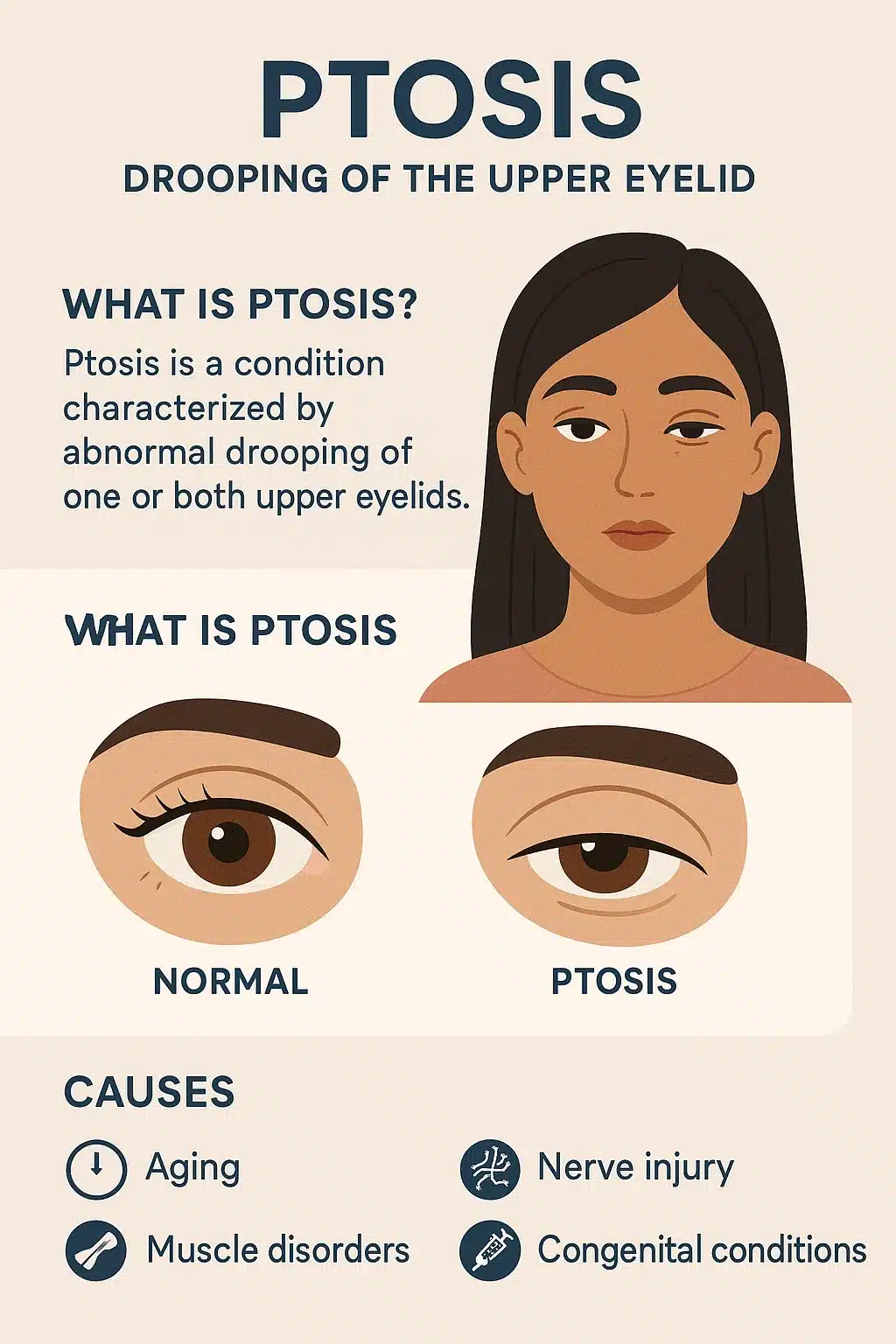Congenital eyelid ptosis is a condition present at birth where the upper eyelid droops and may obstruct vision. At Kopelman Aesthetic Surgery in New York City, Dr. Joel E. Kopelman brings over 35 years of expertise in treating this condition with precision and compassion.
His oculoplastic surgery practice focuses on achieving natural-looking outcomes that restore both function and appearance for patients of all ages.
Table of Contents
ToggleUnderstanding Congenital Ptosis
What Is Congenital Lid or Palpebral Ptosis?
Congenital lid ptosis, also known as congenital blepharoptosis, occurs when a child is born with a drooping upper eyelid. This condition can affect one or both eyes and varies in severity. It is typically caused by underdevelopment of the levator muscle, which is responsible for lifting the eyelid.
In most cases, congenital eyelid ptosis is not painful but can interfere with vision and development. Early diagnosis and proper management are essential to avoid long-term complications like lazy eye (amblyopia).

Types and Severity of Eyelid Droop
There are different types of congenital ptosis based on how severely the eyelid blocks the visual field. These include:
- Mild: The eyelid droops slightly but does not impair vision.
- Moderate: The droop partially covers the pupil and may affect sight.
- Severe: The eyelid fully or nearly covers the pupil, obstructing vision.
Understanding the degree of severity helps guide the best ptosis treatment in NYC, especially in young patients.
Is Congenital Ptosis a Disability?
While congenital ptosis is not classified as a disability in most cases, severe forms can impact vision and learning. When the condition affects daily function, treatment becomes not only cosmetic but medically necessary. Pediatric patients may require accommodations in school if vision is compromised.
Congenital vs. Acquired Eyelid Ptosis
Congenital ptosis is present at birth, while acquired ptosis develops later due to aging, trauma, or medical conditions. The causes and treatment paths differ, making accurate diagnosis critical. Dr. Kopelman’s in-depth evaluations help distinguish between these two categories for appropriate care.
Causes and Risk Factors
Muscle, Nerve, and Genetic Causes
The most common cause of congenital eyelid condition is poor development of the levator muscle. In some cases, abnormal nerve signals from the brain to the eyelid contribute to the droop. Genetic conditions such as Marcus Gunn jaw-winking syndrome or blepharophimosis syndrome may also play a role.
Though most cases are isolated, family history and underlying syndromes can increase the likelihood of occurrence.
Risk Factors in Newborns and Infants
Congenital ptosis may appear as part of a broader syndrome or occur independently. Risk factors include:
- A family history of ptosis or related conditions
- Premature birth or low birth weight
- Congenital cranial nerve palsy
Identifying risk factors early helps ensure timely intervention and better outcomes.
Signs, Symptoms, and Diagnosis
Early Signs in Infants and Children
Parents often notice that one or both eyelids droop more than usual shortly after birth. Other signs include:
- Tilting the head backward to see
- Delayed visual tracking
- Uneven appearance of the eyes
Children with ptosis may also show signs of visual fatigue or rely heavily on compensatory head postures to improve their field of vision. These signs may point to congenital ptosis in an infant and should prompt an ophthalmologic evaluation.
Congenital Eyelid Crease and Visual Impact
In children with congenital ptosis, the eyelid crease may be poorly defined or absent. This is a key sign during a physical exam. If the eyelid blocks part of the pupil, it can interfere with visual development, leading to amblyopia or astigmatism.
Some children with ptosis also develop refractive errors, such as nearsightedness or farsightedness, as a result of the eyelid affecting light entry into the eye. Early detection is essential to prevent permanent vision problems.
Exams, Imaging, and Functional Tests
Diagnosis typically involves a detailed eye exam, eyelid function testing, and measurements of eyelid height. In some cases, imaging studies like MRI may be needed to assess the levator muscle or detect neurological causes.
A rare neurological cause of congenital ptosis is Horner syndrome, which may also involve a smaller pupil or decreased sweating on one side of the face. Accurate diagnosis is crucial for identifying the specific type of ptosis and determining the appropriate eyelid surgery approach.
Treatment Options for Congenital Ptosis
Non-Surgical Treatment Options (Including Eye Drops)
In mild cases, treatment may not be necessary, especially if vision is not affected. Some children benefit from:
- Vision Monitoring
- Patching the unaffected eye to strengthen vision
- Corrective lenses for related visual issues
While eye drops may help certain eye conditions, they do not improve congenital ptosis. Non-surgical approaches are typically supportive rather than corrective.
When Is Surgery Recommended?
Surgery is considered when the eyelid blocks the visual axis or causes vision development issues. In moderate to severe cases, delaying treatment may result in long-term visual impairment. Dr. Kopelman carefully evaluates each patient’s condition and growth before recommending surgery.
The correction of congenital ptosis is often necessary not only for cosmetic reasons but also to prevent vision problems such as amblyopia or developmental delays in children.
Ideal Age and Surgical Techniques
Most surgical correction of congenital ptosis is performed between ages 3 to 5 once the eyelid and facial structures have developed enough for accurate intervention. In cases of severe ptosis of the eyelid in newborns, surgery may be done earlier to protect vision.
Common surgical techniques include:
- Levator resection: Shortening the weak muscle to raise the eyelid.
- Frontalis sling: Connecting the eyelid to the forehead muscle, allowing it to lift via brow movement.
Recovery, Results, and Costs
Recovery time varies by procedure but usually involves mild swelling and bruising for 1–2 weeks. Patients typically see improved eyelid position and a more symmetrical appearance.
The cost of congenital ptosis surgery depends on the technique used, the complexity of the case and insurance coverage. Kopelman Aesthetic Surgery can guide families through these details during the consultation.
Living with Congenital Eyelid Ptosis
Emotional, Social, and Developmental Effects
Beyond physical vision challenges, congenital ptosis can affect a child’s confidence and social interactions. Visible drooping may lead to self-consciousness or teasing, especially in school settings. Addressing these concerns with timely treatment can improve both appearance and self-esteem.
Long-Term Outlook and Follow-Up Care
With proper management, most children with congenital ptosis lead normal lives with minimal visual limitations. Regular follow-up ensures that vision continues to develop correctly and that new issues are addressed early.
Dr. Kopelman monitors his patients over time to ensure the best possible outcomes.
When to Consult a Specialist
Parents should consult an oculoplastic or pediatric ophthalmologist if they notice persistent eyelid drooping, abnormal head posture, or visual delays.
Early evaluation by a qualified expert like Dr. Kopelman can prevent complications and support long-term visual development. Schedule a personalized consultation now.

























